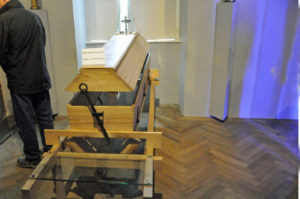
Reusable Coffin in Melk Abbey (Photo by Don Knebel)
In 1089 A.D, Leopold II, the Margrave of Austria, donated a castle overlooking the Danube River to the Benedictine monks for use as an abbey. The Melk Abbey, named after the nearby town, became a well-known center of learning during the Middle Ages, producing important manuscripts in its scriptorium. In the eighteenth century, an imposing new abbey was built on the site to replace the original building that had been damaged by fire. The new abbey included a twin-tower Baroque church adorned inside with frescoes and gold leaf. In 1925, the abbey sold its two-volume Gutenberg Bible and used the proceeds to help finance a massive restoration, which was completed in 1996.
Today, Melk Abbey houses a prestigious co-educational school and is open to the public. Its famous library includes a priceless collection of almost 2000 medieval manuscripts. The abbey also houses an assortment of religious artifacts, including a palm-size Bible and a large money chest with an intricate locking mechanism. Its most unusual item is a wooden coffin with a trap door that could be opened by a lever when the coffin was placed inside the grave opening. The reusable coffin was invented to accommodate a 1784 decree by Holy Roman Emperor Joseph II. He ordered that bodies must be interred without clothes in linen bags to save wood and hasten decomposition. Under the decree, coffins could be used only for transporting the body to the cemetery. Joseph’s decree was so unpopular that it was never implemented. False, but persistent, claims that the body of Mozart, who died in Vienna in 1791, was placed in a reusable coffin are reflected in the movie Amadeus.